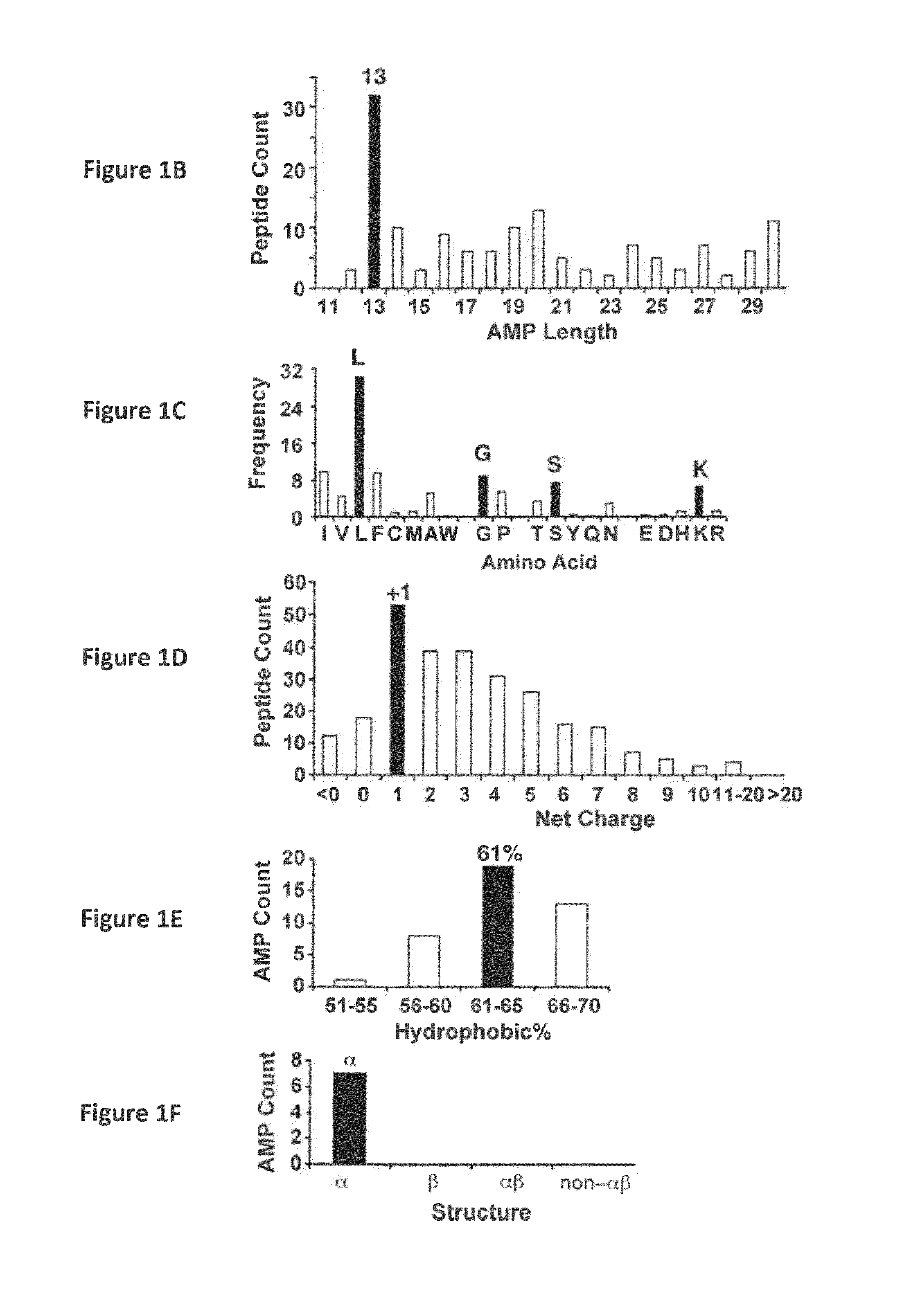Anti-Microbial Peptides and Methods of Use Thereof
a technology of anti-microbial peptides and anti-microbial bacteria, which is applied in the direction of peptides/protein ingredients, drug compositions, peptides, etc., can solve the problem of adding an unwanted burden to medical car
- Summary
- Abstract
- Description
- Claims
- Application Information
AI Technical Summary
Problems solved by technology
Method used
Image
Examples
example 1
[0059]Natural antimicrobial peptides (AMPs) represent excellent antimicrobial candidates (Wang, G. (2010) Antimicrobial Peptides: Discovery, Design and Novel Therapeutic Strategies, CABI, England). Candidates from the antimicrobial peptide database have been screened and several anti-HIV peptides have been identified (Wang et al. (2004) Nucleic Acid Res., 32:D590-D592; Wang et al. (2009) Nucleic Acids Res., 37:D933-D937; Wang et al. (2010) Antimicrob. Agents Chemother., 54:1343-1346). Here, an ab initio design of potent anti-MRSA peptides is provided. All the parameters (e.g. peptide length, charge, and amino acid composition) for peptide design from the beginning were determined by database filtering technology (DFT). DFTamP1, the first AMP designed using this technology, consists merely of four types of frequently occurring amino acids (glycines, leucines, lysines, and serines). The peptide caused bacterial surface damage and killed community-associated MRSA USA300 rapidly. Struct...
example 2
[0080]Based on database screening, six antimicrobial peptides (Ascaphin-8, DASamP1, DASamP2, lycotoxin I, maculatin 1.3, and piscidin 1) were identified that are highly potent against methicillin-resistant Staphylococcus aureus (MRSA) USA300. Among them, DASamP1 (database screened AMP 1) displayed bacteria-specific killing of MRSA in vitro, but not Escherichia coli K12, Bacillus subtilis, or Pseudomonas aeruginosa. Maculatin 1.3 showed Gram-specific activity against only Gram-positive bacteria tested. In addition, DASamP2, ascaphin-8, piscidin 1, and lycotoxin I displayed a broad-spectrum activity against both Gram-positive and Gram-negative bacteria. This is the first study that documents the activity of lycotoxin I against MRSA USA300. In addition, DASamP1 demonstrated in vivo efficacy in a mouse model of catheter-associated MRSA biofilm infection, where early biofilm establishment was suppressed.
[0081]Naturally occurring antimicrobial peptides (AMPs) are universal host defense mo...
example 3
[0088]One of the hurdles in developing peptide-based antimicrobials is peptide stability to protease (Wang, G. (2010) Antimicrobial Peptides: Discovery, Design and Novel Therapeutic Strategies, CABI, England). To identify useful starting templates, a protocol was developed that allows a simultaneous screening for antimicrobial activity as well as peptide stability. This was done by modifying the standard microdilution antimicrobial assays (Wang, G. (2008) J. Biol. Chem., 283:32637-32643). Specifically, the bacterial wells with a high peptide concentration (e.g. 100 μM) are duplicated (e.g., two for antimicrobial assays and two for protease stability assays). As an illustration, chymotrypsin was applied to the duplicated wells at a peptide:protease molar ratio of 25:1. Numerous peptides were screened in this manner. All the peptides were chemically synthesized using the solid-phase method and purified by HPLC to >95% (Genemed Synthesis, TX). The results of select peptides are provide...
PUM
| Property | Measurement | Unit |
|---|---|---|
| pH | aaaaa | aaaaa |
| concentrations | aaaaa | aaaaa |
| accelerating voltage | aaaaa | aaaaa |
Abstract
Description
Claims
Application Information
 Login to view more
Login to view more - R&D Engineer
- R&D Manager
- IP Professional
- Industry Leading Data Capabilities
- Powerful AI technology
- Patent DNA Extraction
Browse by: Latest US Patents, China's latest patents, Technical Efficacy Thesaurus, Application Domain, Technology Topic.
© 2024 PatSnap. All rights reserved.Legal|Privacy policy|Modern Slavery Act Transparency Statement|Sitemap



